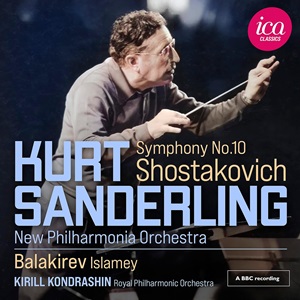
Dmitri Shostakovich (1906-1975)
Symphony No 10 in E minor, Op 93
New Philharmonia Orchestra / Kurt Sanderling
Mily Balakirev (1937-1910)
Islamey, Op 18 (orch. Casella) *
Royal Philharmonic Orchestra / Kirill Kondrashin
rec. live 15 May 1973; *24 January 1978, Royal Festival Hall, London.
ADD
ICA Classics ICAC 5171 [62]
Kurt Sanderling (1912-2011) was born in Germany and began his career there. In 1939 he emigrated to the USSR after the Nazis had removed him from his post at the Berlin State Opera. He remained in the USSR for over twenty years, working as Assistant Conductor of the Leningrad Philharmonic. In 1960 he returned to what was then East Germany and became chief conductor of the Berlin Symphony Orchestra. During his time in Leningrad, he became closely associated, both personally and professionally, with Shostakovich, whose music became a core element in his conducting repertoire. Like Kirill Kondrashin, Sanderling’s interpretations of Shostakovich’s music have a special authority. He recorded a number of the Shostakovich symphonies, including the Tenth, in Berlin; this live account with the New Philharmonia, dating from 1973, is a very welcome supplement to those recordings.
The huge first movement, which here plays for 24:14, is one of the composer’s greatest achievements. Sanderling exercises a tremendous grip from the outset; the opening has exactly the ominous, brooding character I’d expect. As the movement unfolds, Sanderling manipulates the tempi skilfully and most idiomatically. His reading is consistently intense and he takes the New Philharmonia with him; they play marvellously for him. I found all of this completely compelling. It has been suggested many times that the short Allegro movement – it’s in no way a scherzo – is a musical portrait of Stalin. The way he conducts the piece gives me a strong impression that Sanderling subscribed to that idea. The music is played with biting intensity; to be honest, it seems brutal, though not in an uncontrolled fashion. The weight and power of this performance is seriously impressive.
In his notes, Harlow Robinson refers to the frequent use of the composer’s DSCH musical motif in this symphony. He doesn’t reference, however, another motif, comprised of the notes E-A-E-D-A, which permeates the slow movement. It’s now thought this motif may represent in musical notation the first name of Elmira Nazirova, who was one of Shostakovich’s composition pupils at Moscow Conservatoire. This motif is primarily entrusted to the principal horn and the NPO’s horn player is magnificent. Sanderling shapes the music with complete understanding. In the melancholy, slow introduction to the finale, the NPO’s woodwind principals are on top form in their various solos. The main Allegro is driven strongly by Sanderling; there’s great energy and the NPO articulates the music with razor-sharp precision. At the end there’s an enthusiastic ovation, and no wonder; the audience had just heard a terrific performance of the Tenth symphony.
As a filler we hear an example of the work of Kirill Kondrashin (1914-1981). This comes from a concert in which he conducted the Royal Philharmonic Orchestra in January 1978, at the start of the year in which he defected to the West. Balakirev’s Islamey was composed as a solo piano work in 1869 and it’s renowned for the difficulties it poses to pianists. Here, it’s performed in an orchestration by the Italian composer Alfredo Casella (1883-1947).
Harlow Robinson tells us that Casella met Balakirev in 1907, during one of the visits he paid to Russia; he makes the not-unreasonable assumption that Balakirev approved of Casella’s work on Islamey, giving the Italian composer the spur to have his orchestration published in 1908. Actually, I think I’m right in saying that the orchestration by Sergei Lyapunov (1859-1924) is rather more frequently heard and recorded than Casella’s, but it seems to me that the Italian’s work is very successful. Harlow Robinson describes it as a “flashy, theatrical orchestration”. That might seem slightly disapproving of Casella’s work; if so, that’s a bit unfair. Casella was certainly colourful in his scoring, especially of the outer sections of this short piece, and his orchestral palette adds vivid colourings to Balakirev’s music. In this version it’s a brilliant orchestral showpiece and Kondrashin leads an exciting performance.
I’m very glad that ICA Classics have made these two performances commercially available for the first time. That’s especially true of the Shostakovich, which receives a performance worthy of the work’s stature.
These are BBC recordings which have been remastered by Paul Baily. He’s done an excellent job.
Previous review Gregor Tassie
Help us financially by purchasing from




















